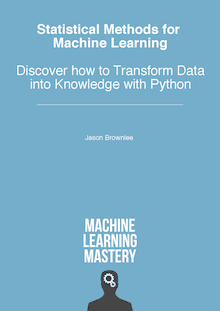The Five Number Summary Can Be Calculated ___________.
How to Calculate the 5-Number Summary for Your Data in Python
Last Updated on August viii, 2019
Data summarization provides a convenient fashion to depict all of the values in a information sample with but a few statistical values.
The mean and standard departure are used to summarize information with a Gaussian distribution, only may not be meaningful, or could even be misleading, if your information sample has a non-Gaussian distribution.
In this tutorial, you lot volition discover the five-number summary for describing the distribution of a data sample without assuming a specific data distribution.
Later completing this tutorial, yous will know:
- Information summarization, such every bit computing the hateful and standard divergence, are simply meaningful for the Gaussian distribution.
- The five-number summary tin can be used to depict a information sample with whatever distribution.
- How to calculate the five-number summary in Python.
Kick-commencement your projection with my new book Statistics for Auto Learning, including step-by-step tutorials and the Python source code files for all examples.
Let'due south go started.

How to Calculate the 5-Number Summary for Your Information in Python
Photo by Masterbutler, some rights reserved.
Tutorial Overview
This tutorial is divided into iv parts; they are:
- Nonparametric Data Summarization
- Five-Number Summary
- How to Summate the Five-Number Summary
- Utilize of the Five-Number Summary
Need aid with Statistics for Machine Learning?
Take my free 7-day e-mail crash course now (with sample code).
Click to sign-upwardly and likewise go a complimentary PDF Ebook version of the course.
Nonparametric Information Summarization
Information summarization techniques provide a fashion to describe the distribution of data using a few key measurements.
The about common example of data summarization is the calculation of the mean and standard divergence for data that has a Gaussian distribution. With these two parameters solitary, you can sympathize and re-create the distribution of the information. The data summary tin compress every bit few every bit tens or as many equally millions individual observations.
The trouble is, you cannot hands calculate the mean and standard difference of information that does non have a Gaussian distribution. Technically, yous tin calculate these quantities, but they do not summarize the data distribution; in fact, they can be very misleading.
In the case of data that does not take a Gaussian distribution, yous can summarize the information sample using the five-number summary.
Five-Number Summary
The five-number summary, or 5-number summary for short, is a not-parametric information summarization technique.
It is sometimes called the Tukey 5-number summary because it was recommended by John Tukey. It tin can be used to describe the distribution of data samples for data with whatever distribution.
As a standard summary for general utilise, the 5-number summary provides most the right amount of item.
— Page 37, Understanding Robust and Exploratory Data Assay, 2000.
The five-number summary involves the calculation of v summary statistical quantities: namely:
- Median: The middle value in the sample, likewise called the 50th percentile or the 2nd quartile.
- 1st Quartile: The 25th percentile.
- 3rd Quartile: The 75th percentile.
- Minimum: The smallest observation in the sample.
- Maximum: The largest observation in the sample.
A quartile is an observed value at a point that aids in splitting the ordered data sample into four equally sized parts. The median, or 2nd Quartile, splits the ordered data sample into two parts, and the 1st and 3rd quartiles split each of those halves into quarters.
A percentile is an observed value at a point that aids in splitting the ordered information sample into 100 equally sized portions. Quartiles are often also expressed every bit percentiles.
Both the quartile and percentile values are examples of rank statistics that can be calculated on a data sample with any distribution. They are used to apace summarize how much of the data in the distribution is behind or in front of a given observed value. For example, one-half of the observations are behind and in front of the median of a distribution.
Note that quartiles are also calculated in the box and whisker plot, a nonparametric method to graphically summarize the distribution of a data sample.
How to Calculate the Five-Number Summary
Calculating the v-number summary involves finding the observations for each quartile likewise as the minimum and maximum observed values from the data sample.
If at that place is no specific value in the ordered information sample for the quartile, such as if there are an even number of observations and nosotros are trying to find the median, then nosotros can summate the mean of the 2 closest values, such as the two eye values.
We can calculate capricious percentile values in Python using the percentile() NumPy function. Nosotros tin use this function to calculate the 1st, 2nd (median), and tertiary quartile values. The role takes both an array of observations and a floating point value to specify the percentile to calculate in the range of 0 to 100. It can likewise takes a list of percentile values to calculate multiple percentiles; for example:
| quartiles = percentile ( information , [ 25 , 50 , 75 ] ) |
By default, the function will calculate a linear interpolation (average) between observations if needed, such every bit in the example of calculating the median on a sample with an even number of values.
The NumPy functions min() and max() tin be used to render the smallest and largest values in the data sample; for example:
| data_min , data_max = information . min ( ) , data . max ( ) |
We tin put all of this together.
The example below generates a data sample drawn from a uniform distribution between 0 and i and summarizes information technology using the five-number summary.
| # calculate a five-number summary from numpy import percentile from numpy . random import rand # generate data sample information = rand ( k ) # summate quartiles quartiles = percentile ( information , [ 25 , 50 , 75 ] ) # calculate min/max data_min , data_max = data . min ( ) , data . max ( ) # impress 5-number summary print ( 'Min: %.3f' % data_min ) print ( 'Q1: %.3f' % quartiles [ 0 ] ) impress ( 'Median: %.3f' % quartiles [ ane ] ) print ( 'Q3: %.3f' % quartiles [ ii ] ) print ( 'Max: %.3f' % data_max ) |
Running the example generates the data sample and calculates the v-number summary to describe the sample distribution.
Nosotros can see that the spread of observations is close to our expectations showing 0.27 for the 25th percentile 0.53 for the 50th percentile, and 0.76 for the 75th percentile, shut to the idealized values of 0.25, 0.l, and 0.75 respectively.
| Min: 0.000 Q1: 0.277 Median: 0.532 Q3: 0.766 Max: i.000 |
Use of the Five-Number Summary
The five-number summary tin can be calculated for a data sample with any distribution.
This includes data that has a known distribution, such equally a Gaussian or Gaussian-like distribution.
I would recommend e'er calculating the five-number summary, and only moving on to distribution specific summaries, such as mean and standard deviation for the Gaussian, in the case that you can place the distribution to which the data belongs.
Extensions
This section lists some ideas for extending the tutorial that yous may wish to explore.
- Draw three examples in a machine learning projection where a five-number summary could be calculated.
- Generate a data sample with a Gaussian distribution and calculate the five-number summary.
- Write a office to calculate a five-number summary for any information sample.
If y'all explore any of these extensions, I'd beloved to know.
Further Reading
This section provides more resources on the topic if you are looking to go deeper.
Books
- Understanding Robust and Exploratory Information Analysis, 2000.
API
- numpy.percentile() API
- numpy.ndarray.min() API
- numpy.ndarray.max() API
Articles
- V-number summary on Wikipedia
- Quartile on Wikipedia
- Percentile on Wikipedia
Summary
In this tutorial, yous discovered the five-number summary for describing the distribution of a data sample without assuming a specific data distribution.
Specifically, you learned:
- Data summarization, such as computing the hateful and standard divergence, are simply meaningful for the Gaussian distribution.
- The five-number summary tin can exist used to depict a data sample with whatsoever distribution.
- How to calculate the 5-number summary in Python.
Practice yous have any questions?
Ask your questions in the comments beneath and I volition do my best to answer.
Source: https://machinelearningmastery.com/how-to-calculate-the-5-number-summary-for-your-data-in-python/

0 Response to "The Five Number Summary Can Be Calculated ___________."
Post a Comment